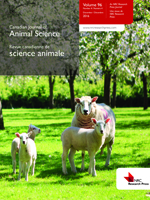Simitzis, P. E., Symeon, G. K., Charismiadou, M. A., Ayoutanti, A. G. and Deligeorgis, S. G. 2011. The effects of dietary hesperidin supplementation on broiler performance and chicken meat characteristics. Can. J. Anim. Sci. 91: 275-282. An experiment was conducted to examine the effects of supplementing broiler feed with hesperidin, a bioflavonoid that is an abundant and inexpensive by-product of citrus cultivation, on growth performance, carcass characteristics, breast meat quality characteristics and the oxidative stability of breast meat. Eighty 308-d-old Ross male broiler chickens were randomly assigned to four groups. One of the groups served as a control (C) and was given commercial basal diets, whereas the other three groups were given the same diets further supplemented with hesperidin at 1.5 g kg-1 (HE1), or hesperidin at 3.0 g kg-1 (HE2), or a-tocopheryl acetate at 0.2 g kg-1 (VE). At 40 d of age, broilers were fasted for 12 h, weighed and slaughtered. After overnight chilling, carcasses were trimmed for breast fillets by removing skin, bones and connective tissue. The right pectoralis major muscle was used for quality parameters estimation, whereas the left pectoralis major muscle for lipid oxidation measurements. No significant differences were observed after dietary hesperidin or a-tocopheryl acetate supplementation in final body weight (kg), body weight gain (g), feed conversion rate and internal organs weight (g). Shear values (N mm-2), intramuscular fat (%) and cooking loss (%) were also not significantly influenced by the dietary treatments. Significant differences were found concerning pH24 and color parameter values among the treatment groups. Measurement of lipid oxidation values showed that as hesperidin increased in the diet, malondialdehyde values decreased in tissue samples, suggesting that hesperidin particularly at 3 g kg-1 exerted an antioxidant effect on chicken tissues (P<0.01). However, dietary a-tocopheryl acetate supplementation at 0.2 g kg-1 of feed displayed greater antioxidant activity than hesperidin at either supplementation rate (P<0.01). In conclusion, hesperidin, an abundant component of citrus pulp, positively influences meat antioxidative properties without negative implications on growth performance and meat quality characteristics in poultry, thus appearing to be an important additive for both the consumer and the industry.
How to translate text using browser tools
1 June 2011
The effects of dietary hesperidin supplementation on broiler performance and chicken meat characteristics
P. E. Simitzis,
G. K. Symeon,
M. A. Charismiadou,
A. G. Ayoutanti,
S. G. Deligeorgis
ACCESS THE FULL ARTICLE
It is not available for individual sale.
This article is only available to subscribers.
It is not available for individual sale.
It is not available for individual sale.

Canadian Journal of Animal Science
Vol. 91 • No. 2
June 2011
Vol. 91 • No. 2
June 2011
acétate d'a-tocophéryl
a-tocopheryl acetate
hesperidin
hespéridine
oxidation
oxydation
Poultry breast meat




